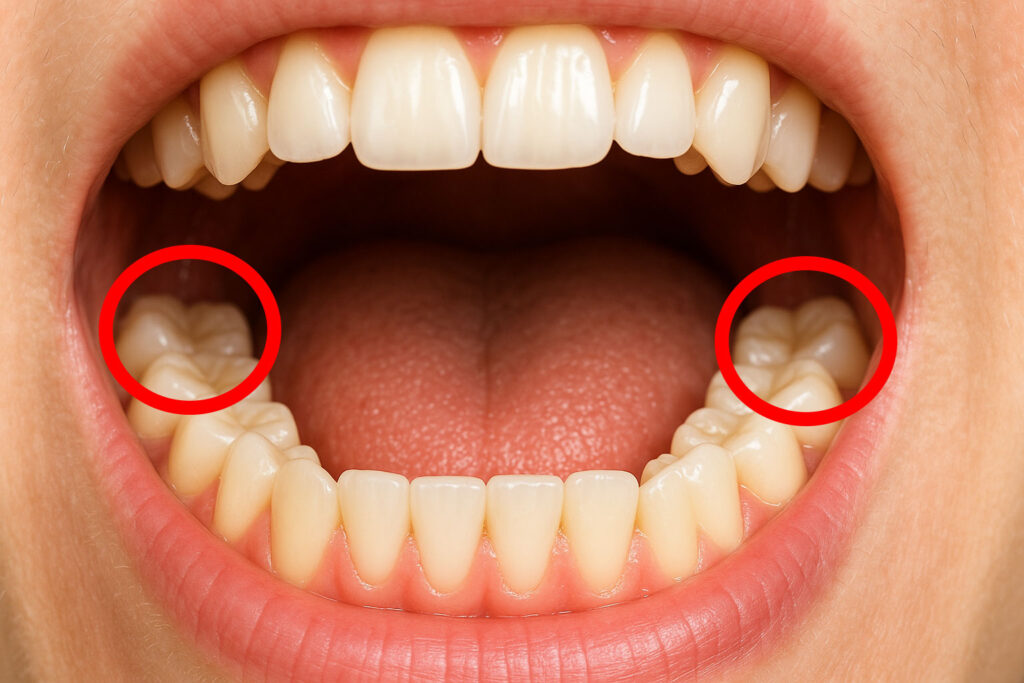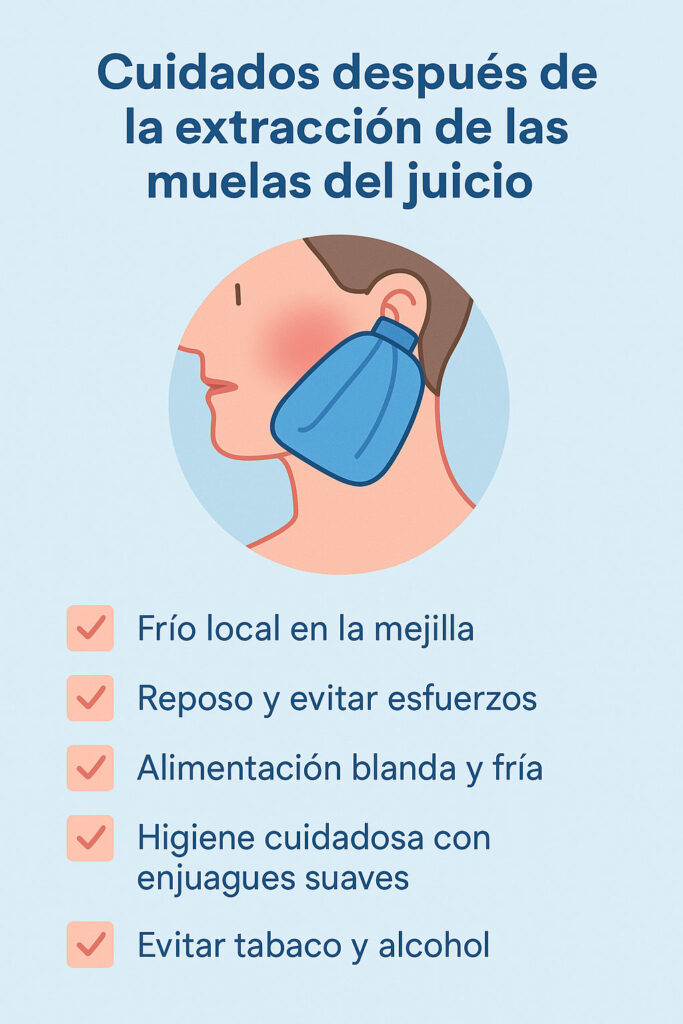Wisdom teeth are the last molars to appear in the mouth, usually between the ages of 17 and 25. They are so named because they usually erupt at a stage when we have reached adulthood and, in theory, “maturity” or “wisdom.”
Unlike other teeth, these molars do not always serve a clear purpose. In the past, when diets were much harder and more abrasive, more teeth were needed to grind food properly. Today, with softer diets and advanced hygiene techniques, wisdom teeth have lost some of their usefulness.
The important thing to understand is that they do not always cause problems. In many people, they erupt correctly and do not require any treatment. However, in other cases, they may come in crooked, become trapped under the gum, or not have enough space, causing discomfort or complications that should be monitored closely.
>>> Do you live in Mallorca? Book your free first appointment <<<
In this article, we will explain what wisdom teeth are exactly, what symptoms they can cause, when they need to be removed, and how to take care of yourself after surgery, so that you have all the necessary information and know what to do in each situation.
What are wisdom teeth?
Wisdom teeth are the third molars, i.e., the last pair of teeth to appear in each dental arch: two at the top and two at the bottom, located at the very back of the mouth. They usually erupt between the ages of 17 and 25, although in some people they never appear or do so later.
From an evolutionary standpoint, these molars were useful for chewing tough, fibrous diets. Over time, diets became softer and human jaws tended to become smaller. This explains why many people today do not have enough space for their wisdom teeth to erupt properly.
When wisdom teeth come in properly positioned and with enough space, they function like any other molar. The problem arises when they are impacted (they don’t come out completely), partially covered by the gum, or erupt in the wrong direction, which increases the risk of pain, inflammation, and infection.

Most common symptoms and discomfort associated with wisdom teeth
Wisdom teeth do not always cause pain or problems, but when they do not erupt properly, they can lead to a series of characteristic symptoms that are important to recognize:
Pain or pressure in the jaw
When teeth try to come through and there is not enough space, they exert pressure on neighboring teeth and cause pain in the back of the mouth or even throughout the jaw.
Swollen and red gums
It is common for the tissue surrounding the tooth to become swollen and sensitive when chewing or brushing. In some cases, part of the gum may partially cover the tooth, trapping food debris and bacteria.
Difficulty opening the mouth
If the inflammation is severe, it can limit normal mouth opening, causing discomfort when speaking or chewing.
Bad breath or unpleasant taste in the mouth The accumulation of bacteria in the back of the mouth, which is difficult to clean, promotes the development of halitosis or a persistent unpleasant taste.
Radiating pain
Sometimes, the discomfort can spread to the ear, head, or throat, confusing the patient about the true source of the pain.
When wisdom teeth can cause problems
Although wisdom teeth can erupt without causing complications, in many cases they become a source of discomfort and dental problems. The most common situations in which they cause problems are:
Lack of space in the jaw
When the arch is too small, wisdom teeth do not have enough room to erupt. This can cause them to push against other teeth, resulting in crowding or misalignment.
Partial eruption
If the tooth is partially covered by the gum, an area forms where bacteria and food debris accumulate. This promotes infections such as pericoronitis, which causes pain, inflammation, and bad breath.
Poorly positioned growth
Some molars erupt tilted toward the neighboring tooth or outside the arch, increasing the risk of cavities and damage to the adjacent tooth. Sometimes, they remain completely retained within the bone, causing pain and cysts.
Damage to adjacent teeth. Constant contact with the second molar can cause wear or decay in that tooth, as well as pain and localized inflammation.
Recurring discomfort
Even when the initial symptoms subside, poorly positioned wisdom teeth tend to cause repeated episodes of inflammation and pain, which affects the patient’s quality of life.
Treatment options for wisdom teeth
Wisdom teeth do not always need to be extracted. In many cases, when they erupt correctly and remain in the right position, it is sufficient to have them checked periodically at the dentist’s office. However, when they cause discomfort or present a risk of complications, the dentist may recommend different approaches:
Regular observation and checkups
If wisdom teeth erupt normally, there is no pain or inflammation, and they can be cleaned well with brushing, it is best to simply have annual X-rays and checkups to ensure that no problems arise.
Preventive extraction
In some cases, even if the tooth is not yet causing symptoms, an X-ray may reveal that there is not enough space for it or that it will grow in the wrong position. In these situations, the dentist may recommend preventive extraction to avoid future problems such as crowding, cavities, or repeated infections.
Therapeutic extraction
When teeth have already caused pain, recurrent infections, damage to neighboring teeth, or limited mouth opening, extraction becomes the recommended treatment.
What is the procedure like?
- It is performed under local anesthesia.
- The duration of the procedure depends on the position of the tooth (erupted, semi-erupted, or impacted).
- It may require a small incision in the gum and, in some cases, fragmenting the tooth to remove it more easily.
- After extraction, stitches are placed and removed approximately one week later.
5 myths about wisdom teeth
There are many misconceptions surrounding wisdom teeth. Clarifying these misconceptions helps you make informed decisions when you experience discomfort or have doubts about whether or not to have them removed.
Myth 1: Wisdom teeth always need to be removed
This is not true. If they erupt properly aligned, have enough space, and do not cause problems, they can be kept without the need for surgery.
Myth 2: They only cause pain during adolescence
Although they usually erupt between the ages of 17 and 25, symptoms may appear later or even persist intermittently.
Myth 3: Extraction is very painful
With local anesthesia and current techniques, the procedure is painless. Any discomfort afterward can be controlled with medication and simple care.
Myth 4: If they don’t hurt, there’s no need to monitor them
Even if they don’t hurt, wisdom teeth can be impacted or grow in the wrong position, causing cavities in neighboring molars or infections. That’s why regular checkups are so important.
Myth 5: All wisdom teeth come through in the mouth
In many people, they remain trapped in the bone and never fully erupt. These cases may require X-ray monitoring to prevent complications.
Care after wisdom tooth extraction
After the extraction of a wisdom tooth, aftercare is essential to promote healing, reduce discomfort, and prevent complications. Although each patient is different and you should always follow your dentist’s instructions, there are a number of general recommendations:
Immediate recommendations
- Keep the gauze in place at the extraction site for 30–60 minutes to control bleeding.
- Apply cold compresses to the cheek for 10–15 minutes at a time to reduce swelling.
- Rest for the rest of the day, avoiding intense physical exertion.
- Do not smoke, drink alcohol, or rinse vigorously for the first 24 hours, as this hinders healing.
- Soft, cold foods for the first few hours (yogurt, purées, ice cream without chunks).
Hygiene and aftercare
- Brush gently, avoiding the extraction site for the first few days.
- Gently rinse with warm water and salt after 24 hours to keep the area clean.
- Follow the analgesic or antibiotic medication guidelines indicated by the dentist.
Warning signs after surgery
- Very intense pain that does not improve with painkillers.
- Heavy or persistent bleeding.
- Fever or general malaise.
- Swelling that progressively increases after 2–3 days.
In any of these cases, it is necessary to see a dentist immediately for a checkup.
Prevention and control at home
Although wisdom teeth cannot always be prevented or controlled when they erupt, there are measures that can help reduce the risk of complications and detect any problems early on.
Hygiene adapted to the back of the mouth
Wisdom teeth are located in the deepest part of the mouth, where it is most difficult to reach with a toothbrush. Therefore, it is advisable to use:
- Small or special brushes for posterior areas.
- Interdental brushes and oral irrigators, which help remove debris from tight spaces.
- Specific mouthwashes that reinforce cleaning in cases of inflammation.
Regular checkups
It is advisable to visit the dentist from adolescence onwards to assess the available space and position of wisdom teeth before they erupt. This allows for planning follow-up care or preventive extraction if deemed necessary.
Control X-rays
Orthopantomography (panoramic X-ray) is a tool that allows us to visualize the exact position of wisdom teeth and their relationship with the bone and mandibular nerve. Thanks to this technique, anomalies can be detected even before symptoms appear.
Healthy lifestyle
Maintaining good daily oral hygiene, avoiding tobacco, and eating a balanced diet are habits that also influence overall oral health and reduce the chances of complications.

Article summary
Wisdom teeth are a natural part of our dentition, but their eruption is not always straightforward. In some cases, they appear without problems and function like any other molar, while in others they may become impacted, erupt in the wrong position, or cause complications in the gums and neighboring teeth.
The most important thing to understand is that not all wisdom teeth need to be extracted, but they do need to be monitored with regular checkups and, in many cases, with X-rays to anticipate their development. When they cause pain, infection, or risk to adjacent teeth, extraction becomes the safest treatment.
Aftercare and preventive measures—adapted hygiene, checkups, and healthy habits—are essential for maintaining a healthy mouth and avoiding long-term complications.
The key message is clear: each case is unique. The decision on what to do with wisdom teeth should always be made together with a dentist, assessing the position, available space, and overall condition of the mouth.
| Topic | Key content |
|---|---|
| Introduction | Wisdom teeth are the third molars and usually appear between the ages of 17 and 25. They do not always cause problems, but they require monitoring. |
| What are wisdom teeth? | The last molars in each arch. Useful in evolutionary terms, today they may lack a clear function. They may erupt properly or remain impacted in the bone. |
| Symptoms of eruption and most common discomforts | Pain or pressure in the back of the jaw, swollen gums, difficulty opening the mouth, bad breath, pain radiating to the ear or head. |
| When problems may arise | Lack of space (crowding), partial eruption with risk of pericoronitis, abnormal positions (tilted, impacted), caries or damage to the adjacent molar, recurrent episodes. |
| Treatment options | Observation with periodic checkups; preventive extraction if there is high risk; therapeutic extraction in case of pain, infections, or damage to other teeth. |
| Care after extraction | Local cold, rest, soft food, avoid tobacco/alcohol, gentle hygiene after 24 hours, watch for warning signs (severe pain, bleeding, fever). |
| Prevention and control at home | Hygiene adapted to the back of the mouth (small/interdental brushes), regular check-ups, orthopantomography to assess position, healthy habits. |
| 5 myths about wisdom teeth |
1) "They always have to be removed" — False. 2) "They only hurt during adolescence" — False. 3) "Extraction is very painful" — False (local anesthesia and good pain control). 4) "If they don't hurt, you don't have to monitor them" — False (X-ray monitoring). 5) "They all come out into the mouth" — False (they can become impacted). |
| Conclusion | Not all require extraction, but all require monitoring. The decision is individual, based on space, position, and symptoms to prevent complications. |
 Whatsapp
Whatsapp




